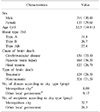1. Hart A, Smith JM, Skeans MA, Gustafson SK, Wilk AR, Robinson A, et al. OPTN/SRTR 2016 annual data report: kidney. Am J Transplant. 2018; 18 Suppl 1:18–113.

2. Shafer TJ, Wagner D, Chessare J, Schall MW, McBride V, Zampiello FA, et al. US organ donation breakthrough collaborative increases organ donation. Crit Care Nurs Q. 2008; 31:190–210.

4. Domínguez-Gil B, Danovitch G, Martin DE, López-Fraga M, Van Assche K, Morris ML, et al. Management of patients who receive an organ transplant abroad and return home for follow-up care: recommendations from the Declaration of Istanbul Custodian Group. Transplantation. 2018; 102:e2–e9.
5. International Summit on Transplant Tourism and Organ Trafficking. The declaration of Istanbul on organ trafficking and transplant tourism. Clin J Am Soc Nephrol. 2008; 3:1227–1231.
6. International Registry in Organ Donation and Transplantation. Preliminary numbers 2018: IRODaT international registry in organ donation and transplantation [Internet]. Barcelona: International Registry in Organ Donation and Transplantation;cited 2019 Dec 20. Available from:
www.irodat.org.
7. Korea Organ Donation Agency. KODA annual report 2018. Seoul: Korea Organ Donation Agency;2019.
8. Ministry of Health and Welfare. Related laws such as organs and human tissues in 2019. Sejong: Ministry of Health and Welfare;2019.
9. Levin A. The impact of first-person consent legislation on the supply of deceased organ donors [thesis]. Allendale Charter Twp, MI: Grand Valley State University;2014.
10. Traino HM, Siminoff LA. Attitudes and acceptance of First Person Authorization: a national comparison of donor and nondonor families. J Trauma Acute Care Surg. 2013; 74:294–300.
11. Callison K, Levin A. Donor registries, first-person consent legislation, and the supply of deceased organ donors. J Health Econ. 2016; 49:70–75.

12. Statistics Korea. Changes in death rates by major causes of death from annual report on the causes of death statistics 2018. Daejeon: Statistics Korea;2018.
13. Lee J, Lee JG, Jung I, Joo DJ, Kim SI, Kim MS, et al. Development of a Korean liver allocation system using model for end stage liver disease scores: a nationwide, multicenter study. Sci Rep. 2019; 9:7495.

14. Park UJ, Kim MY, Kim HT, Cho WH. Validation of the KDRI in Korean deceased donor kidney transplantation. J Korean Soc Transplant. 2014; 28:78–82.

15. Yang JS, Gu TY, Lee JY, Yoon YS, Chung YI, Byun HS. Suggestions for improvement of the expanded category of kidney transplantation donor in Korea. Wkly Health Dis. 2018; 11:1231–1237.
16. Siminoff LA, Alolod GP, Wilson-Genderson M, Yuen EYN, Traino HM. A comparison of request process and outcomes in donation after cardiac death and donation after brain death: results from a national study. Am J Transplant. 2017; 17:1278–1285.

17. Bernat JL, D'Alessandro AM, Port FK, Bleck TP, Heard SO, Medina J, et al. Report of a national conference on donation after cardiac death. Am J Transplant. 2006; 6:281–291.

18. Center for Korean Network for Organ Sharing. Annual report of organ transplantation and tissue donation in 2018. Cheongju: Center for Korean Network for Organ Sharing;2019.
19. Lee SH, Huh KH, Lee HS, Kim HJ, Kim MS, Joo DJ, et al. Waiting time for deceased donor kidney allocation in Korea: a single center experience. J Korean Soc Transplant. 2012; 26:32–37.

20. Ministry of Justice. Act on decisions on life-sustaining treatment for patients in hospice and palliative care or at the end of life (partially revised on Dec 2018. Act No. 15912). Gwacheon: Ministry of Justice;2018.
21. Antoine C, Mourey F, Prada-Bordenave E. Steering committee on DCD program. How France launched its donation after cardiac death program. Ann Fr Anesth Reanim. 2014; 33:138–143.

22. Andrews PA, Burnapp L, Manas D. British Transplantation Society. Summary of the British Transplantation Society guidelines for transplantation from donors after deceased circulatory death. Transplantation. 2014; 97:265–270.

23. Manara AR, Murphy PG, O'Callaghan G. Donation after circulatory death. Br J Anaesth. 2012; 108 Suppl 1:i108–i121.

24. Summers DM, Johnson RJ, Allen J, Fuggle SV, Collett D, Watson CJ, et al. Analysis of factors that affect outcome after transplantation of kidneys donated after cardiac death in the UK: a cohort study. Lancet. 2010; 376:1303–1311.

25. Sade RM. Brain death, cardiac death, and the dead donor rule. J S C Med Assoc. 2011; 107:146–149.
26. Lee WS. The influence of college students' social withdrawal on satisfaction with life: with emphasis on the mediating effect of aggression. Health Soc Welf Rev. 2018; 38:75–108.











 PDF
PDF ePub
ePub Citation
Citation Print
Print









 XML Download
XML Download